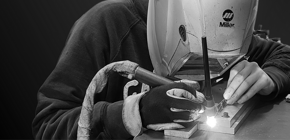First and foremost, it must be clearly established that individual welding operators are not capable, under the regulations of the federal government, of being accredited for NAVSEA on their own – leaving aside self-employed persons for now. The Federal Acquisition Regulation (FAR) mandates that a company has a quality assurance and management system in place prior to applying for NAVSEA certification. Essentially, welders have to be certified to their employer’s training and QA surveillance programs. A self-employed individual would therefore be regarded as their own employer and have to provide proof of a QA program that meets the expectations and requirements of their customers and industry standards.
In light of this fact, the contents of this article will first go over how a company may become certified and then discuss the requirements for the operators.
If an institution is interested in pursuing a certification under NAVSEA, they must first partner with a Level III Test Examiner to approve its training and quality management systems. The necessary standards and military specifications can be found online and will be vital in producing a written procedure that meets all NAVSEA welding requirements for the company’s standard(s) of choice. It is highly recommended that organizations interested in establishing their own NAVSEA programs purchase two essential American Society for Nondestructive Testing (ASNT) products to start exploring the possibility: Recommended Practice No. SNT-TC-1A and the Implementing Recommended Practice No. SNT-TC-1A package. Once the training procedure has been approved, the company must submit WPSs and PQRs that follow the approved processes.
As an example, a company interested in pursuing an accreditation to the NAVSEA spec NAVSEA S9074-AR-GIB-010/278 or NAVSEA S9074-AQ-GIB-010/248 should also look into acquiring the military standards of MIL-STD-2035A, MIL-STD-271, and MIL-STD-22D. By gaining a comprehensive understanding of these documents and their combined requirements, they will be better able to put together their training and quality assurance documents to get approval.
The documents listed above are often noted as being the mere foundation of such an endeavor, as there are often more military documents and materials that provide further insights into completing the entire process. For this reason, it is standard practice for companies new to NAVSEA work to be encouraged to find an experienced Level III, certified to IAW, who can further guide their exploration and understanding of NAVSEA requirements. It should be noted that a Level III that has procedure approval authority will likely be necessary if a company’s work contract does not mention submitting NAVSEA procedures for approval; when in doubt, it is always recommended to clarify with the relevant, assigned contract specialists. Another potential resource for companies interested in breaking into the naval industry would be the liaison personnel employed directly by the Primes; they are usually more than happy to answer questions and direct inquisitive minds to further resources.
Finally, the welder of the company can then pursue certification to the procedures now put in place. An operator is required to pass a written and visual acuity test and a demonstration of welder competency (i.e. produce a passing number of weld coupons). In the pursuit of meeting these requirements, they also must undergo at least 24 hours of training and a sum of 240 hours of NAVSEA welding experience. In this way, the welder, under their company’s already formed and approved systems, will be able to add the NAVSEA certification to their list of skills and accomplishments. The overall approval process, from the top down, can take anywhere from several months to a few years.
Additionally, should a company desire a more complete or all-encompassing vantage point on their NAVSEA systems and undertakings, they can cultivate their chosen employee(s) to the status of Level III themselves. An explanation of such a process, however, would necessitate another blog post. It is a viable option, and one that many companies find themselves approaching as they move forward with their NAVSEA welding certification efforts.

COMMENTS